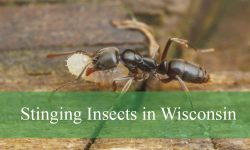Ohio is home to a fascinating diversity of caterpillars, many of which transform into beautiful moths and butterflies. However, not all of them are harmless — several species are covered in venomous spines or irritating hairs capable of causing painful stings, rashes, and swelling. These stinging caterpillars use their natural defenses to ward off predators but can accidentally harm humans who encounter them while gardening or hiking.
From the fuzzy Puss Caterpillar to the brightly patterned Saddleback Caterpillar, Ohio’s stinging species come in many shapes and colors. Each one hides a complex mechanism of venom delivery that can range from mild irritation to severe pain. Although their appearance may seem soft and inviting, even a gentle touch can result in an unpleasant sting.
Learning to identify these species is the best way to avoid injury while still appreciating their role in the ecosystem. In this guide, we’ll explore 10 types of stinging caterpillars in Ohio, describing their appearance, habitat, behavior, and sting effects in detail so you can recognize and safely steer clear of them in the wild.
Different Types of Stinging Caterpillars in Ohio
Puss Caterpillar (Megalopyge opercularis)
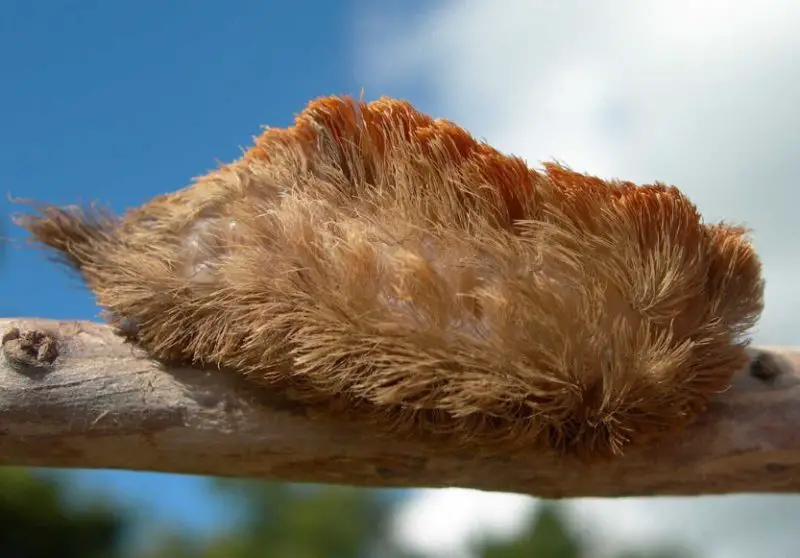
The Puss Caterpillar, often regarded as the most venomous caterpillar in North America, is occasionally spotted in southern Ohio during warm months. This fuzzy caterpillar has a dense coating of long, silky hair that gives it the appearance of a small tuft of fur or a “cotton ball.” Despite its cute look, beneath those soft hairs are venomous spines capable of delivering an extremely painful sting.
In terms of size, the Puss Caterpillar typically measures about 1 to 1.5 inches long. It varies in color from grayish-white to golden brown, depending on its maturity. The long, luxurious fur hides clusters of hollow spines that inject venom when touched, similar in intensity to a bee or wasp sting but lasting much longer.
The sting causes immediate pain that can radiate through the affected limb. Victims often experience burning sensations, swelling, red welts, and sometimes nausea or headaches. In severe cases, contact may lead to systemic reactions requiring medical attention. The spines break off easily, embedding into the skin and releasing venom gradually.
Puss Caterpillars are usually found on shade trees like oaks, elms, and hackberries. They prefer wooded areas, gardens, and parks where host trees are abundant. They are most active from late summer to early fall, feeding on leaves before pupating. Because of their venom, it’s best to observe them from a distance and avoid handling them at all costs.
Saddleback Caterpillar (Acharia stimulea)
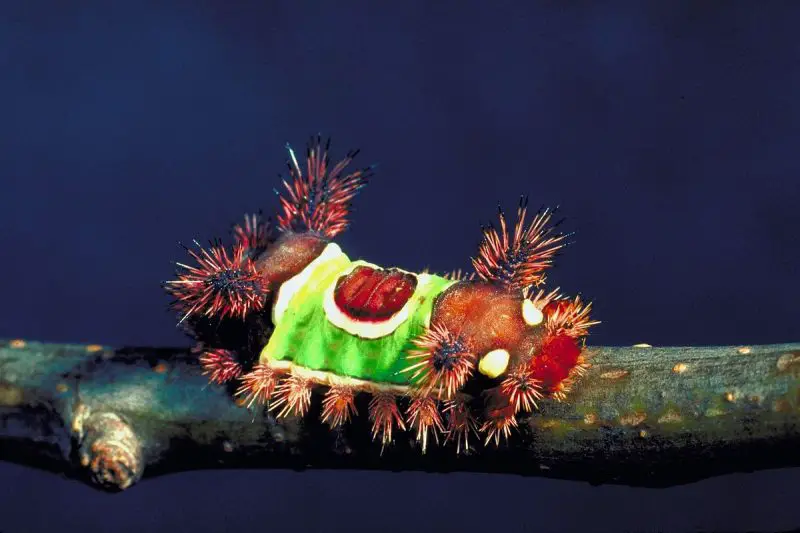
The Saddleback Caterpillar is one of the most recognizable stinging caterpillars in Ohio due to its distinct coloration. Its bright green body features a large brown “saddle” marking in the center, bordered with white — a striking warning pattern that signals its toxicity. This species is small but potent, armed with venomous spines that can inflict painful stings.
Adults measure about 1 inch long. The body is short and stubby, with clusters of spines extending from both ends and along the sides. These spines are connected to venom glands that inject toxins upon contact. The sting feels like an electric shock followed by intense burning, redness, and swelling. For sensitive individuals, it may also cause nausea, migraines, or breathing difficulty.
Saddleback Caterpillars are solitary feeders, often hiding under leaves during the day. They consume a wide range of host plants including oaks, maples, corn, and ornamental shrubs. They are often found in gardens, parks, and forest edges in Ohio during mid to late summer.
Their behavior is generally non-aggressive — they rely on bright coloration as a deterrent. However, accidental contact while gardening or pruning can lead to severe stings. Applying adhesive tape to remove embedded spines and washing the area with soap and water can help reduce discomfort.
Io Moth Caterpillar (Automeris io)
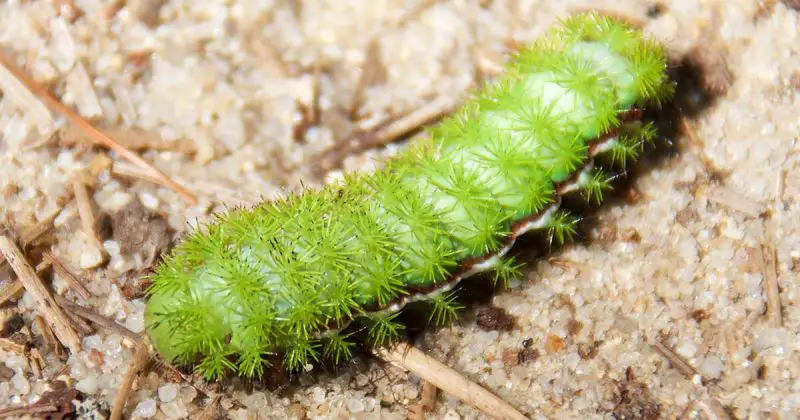
The Io Moth Caterpillar is known for both its stunning adult form and its formidable larval defense. When young, these caterpillars are orange, but as they mature, they turn bright green with red and white stripes along their sides. The body is covered in branching spines tipped with venom that can deliver a sharp sting upon the slightest touch.
Fully grown Io Moth Caterpillars can reach up to 2.5 inches long, making them one of the larger stinging caterpillars in Ohio. The spines are brittle and connected to venom sacs that release toxins when they pierce human skin. Contact causes burning, itching, and rash-like welts, often compared to nettle burns but more intense. The irritation usually subsides after several hours but may persist for a day or more in sensitive individuals.
These caterpillars feed on a wide range of plants including willow, birch, elm, cherry, and clover. They can be found in wooded areas, meadows, and gardens throughout Ohio, especially during midsummer. They are active during daylight and may be seen resting on the undersides of leaves.
Though painful, their sting is not life-threatening. The Io Moth Caterpillar uses its spines as a last defense against predators such as birds and wasps. Its bright green body acts as camouflage among leaves, but when disturbed, its spiny defenses make it an unpleasant meal for any would-be attacker.
Buck Moth Caterpillar (Hemileuca maia)
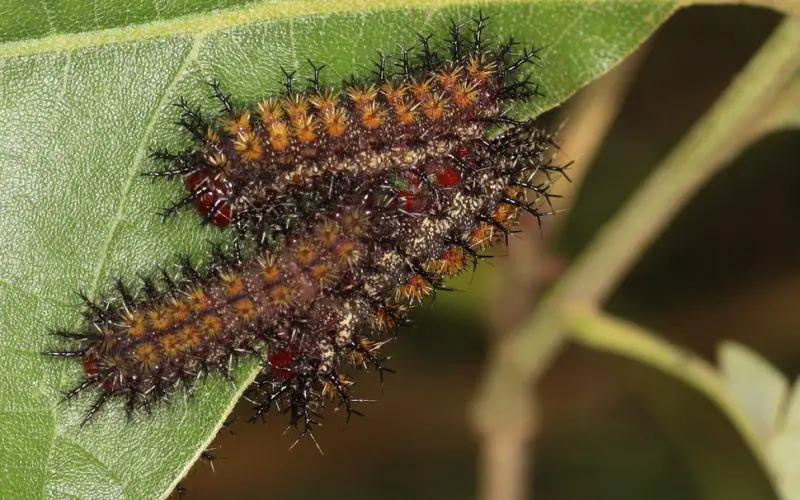
The Buck Moth Caterpillar is another striking and venomous species occasionally found in Ohio, particularly in oak-dominated forests. It is large, spiny, and covered in dark, branching spines that make it look intimidating — and for good reason. The venom-filled spines can easily puncture the skin, causing severe pain, burning, and inflammation.
These caterpillars can grow up to 2.5 inches in length. They are typically dark brown to black with lighter stripes running along the body. The spines are arranged in tufts along each segment and connected to small venom glands. When brushed against, the spines break off and inject venom into the skin, causing immediate pain, redness, and swelling.
The Buck Moth Caterpillar is mostly found feeding on oak leaves but can occasionally be seen on willow or hazel. They prefer dry, open woodlands and oak savannas, habitats common in southern and central Ohio. They are most active in late summer and early fall when oak foliage is abundant.
Despite their painful sting, Buck Moth Caterpillars play a role in forest ecosystems by serving as prey for birds and parasitic wasps. When disturbed, they often rear up or thrash their bodies in warning, displaying their spiny armor before slowly retreating under leaves.
White-Marked Tussock Moth Caterpillar (Orgyia leucostigma)
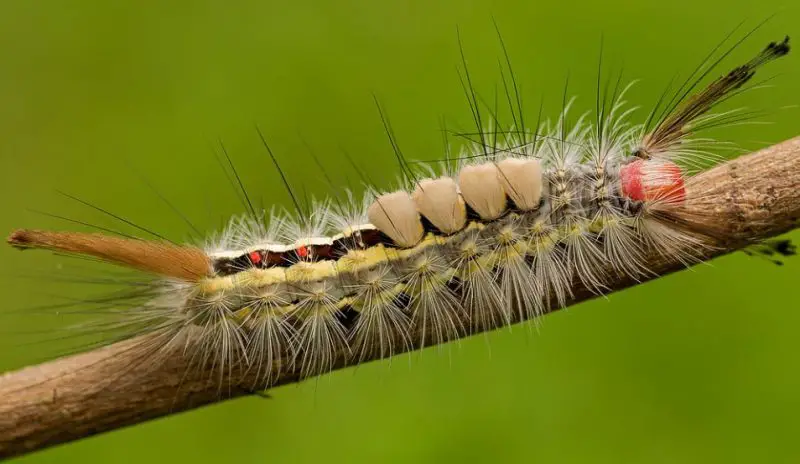
The White-Marked Tussock Moth Caterpillar is one of the most eye-catching and easily recognized species in Ohio. It has a colorful appearance with bright red head, black and white striped body, and four dense white tufts of hair along its back. Despite its beauty, it can cause mild to moderate skin irritation in humans due to its defensive hairs.
This species grows about 1.25 inches long. The body is covered with hair-like bristles that may contain toxins capable of causing allergic reactions or rashes. While not as venomous as the Puss or Saddleback Caterpillar, its urticating hairs can still lead to redness, itching, and irritation, especially in children or people with sensitive skin.
The caterpillar is commonly found in residential areas, feeding on a wide variety of trees such as maples, birches, and oaks. They often appear on the sides of buildings or fences during migration to pupate. In Ohio, they are most active from late summer through early fall.
Their behavior is quite mobile — they move from tree to tree searching for fresh foliage. When disturbed, they may rear up or release fine hairs into the air. While their sting is not severe, direct contact should still be avoided. Washing the affected area and using adhesive tape to remove hairs can help relieve discomfort.
Spiny Oak Slug Caterpillar (Euclea delphinii)
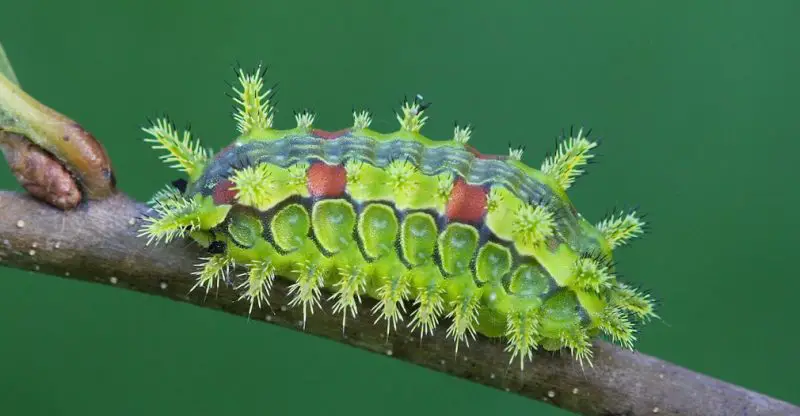
The Spiny Oak Slug Caterpillar is a small but vibrantly colored species that can deliver a surprisingly painful sting. Found throughout Ohio’s wooded regions, it’s adorned with a variety of colors — bright green, orange, and yellow patterns with radiating spiny tufts. These spines are venomous and connected to glands that inject toxins when brushed against, serving as an effective defense against predators.
Adults typically measure between 0.75 and 1 inch long. The body is oval and flattened, with spiny projections on the sides and rear. The spines can easily puncture human skin, releasing venom that causes sharp pain, itching, and swelling. In sensitive individuals, the reaction may include burning sensations, redness, or small welts that last several hours. Despite their small size, their sting can be as painful as that of larger caterpillars.
These caterpillars feed on a wide range of deciduous trees, including oak, cherry, beech, and maple. They prefer shaded areas such as forest edges and backyards with mature trees. Their flattened shape allows them to cling closely to leaf surfaces, making them difficult to spot. They are most active during mid to late summer.
The Spiny Oak Slug Caterpillar does not seek out contact; most stings occur accidentally when someone brushes against leaves where it rests. After feeding, it pupates in a tough cocoon, often attached to bark or leaf litter. Handling them is strongly discouraged, as even light contact can trigger an intense sting.
Monkey Slug (Phobetron pithecium)
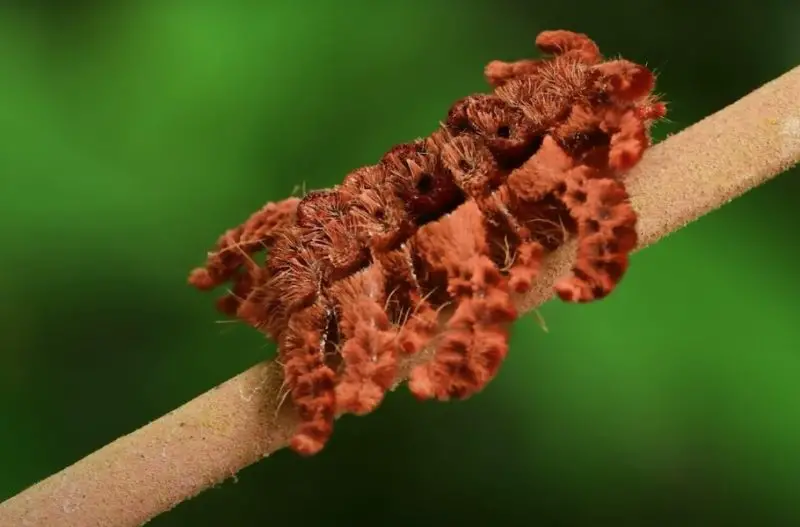
The Monkey Slug, sometimes called the Hag Moth Caterpillar, is one of the strangest and most alien-looking species in Ohio. Covered in thick, brown hair-like setae, its body appears to have multiple “arms” radiating outward, resembling a tiny hairy spider or dried leaf. Beneath this bizarre disguise are stinging spines that deliver mild to moderate irritation upon contact.
Measuring about 1 inch long, the Monkey Slug’s body is irregular in shape and often difficult to distinguish from natural debris. The spines are hidden under its matted hairs and can cause sharp burning pain followed by redness and itching. The reaction is typically less severe than with Puss or Saddleback Caterpillars, but sensitive individuals may develop welts or prolonged irritation.
Monkey Slugs are usually found in deciduous forests, feeding on oak, apple, hickory, and ash trees. They prefer shaded, moist habitats and are most active during late summer and fall. Because they blend so well with tree bark and leaf litter, they often go unnoticed until touched.
This species relies heavily on camouflage for protection, remaining still for long periods. When disturbed, it may curl its “arms” inward and remain motionless. Though its sting is not dangerously toxic, the Monkey Slug’s hairs can embed in the skin, so brushing them off gently and washing the area is recommended after contact.
Stinging Rose Caterpillar (Parasa indetermina)
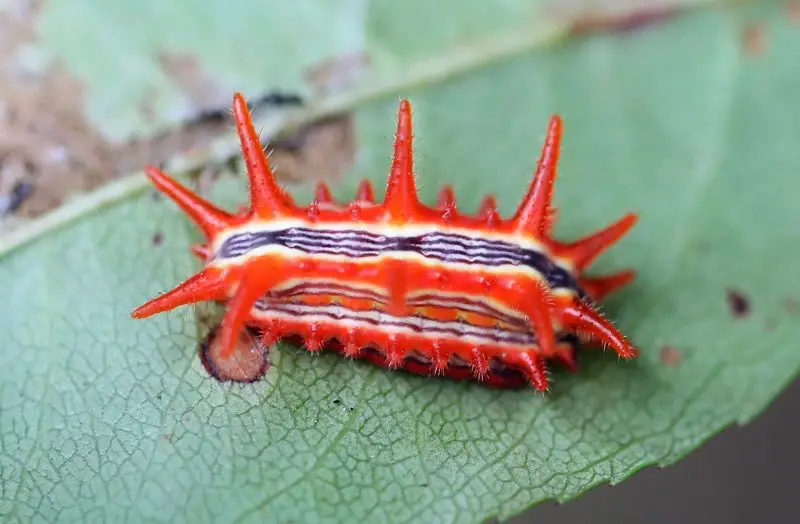
The Stinging Rose Caterpillar is a vividly colored species found across Ohio’s woodlands, gardens, and hedgerows. Its bright yellow to orange body is decorated with red stripes and rows of sharp, branching spines tipped with venom. The striking coloration serves as a warning to predators — and to humans — that it’s best left untouched.
These caterpillars reach about 1 inch in length. The spines contain venom that can cause immediate stinging sensations, burning, redness, and swelling when brushed against. For some people, the irritation may spread beyond the contact area, resembling a nettle rash. The pain generally fades within a few hours, but washing and applying cold compresses can help soothe the skin.
The Stinging Rose Caterpillar feeds on a wide range of shrubs and trees, including roses, oak, hickory, and apple. It prefers sunny edges of wooded areas and gardens, where its host plants thrive. In Ohio, sightings are most common from midsummer through early fall.
Though they are solitary feeders, their bright appearance makes them easy to identify. They are non-aggressive and move slowly, relying on their vivid coloration and venomous defenses to deter predators. Gardeners should exercise caution when pruning roses or ornamental trees, as accidental contact is the most common cause of stings.
Banded Tussock Moth Caterpillar (Halysidota tessellaris)
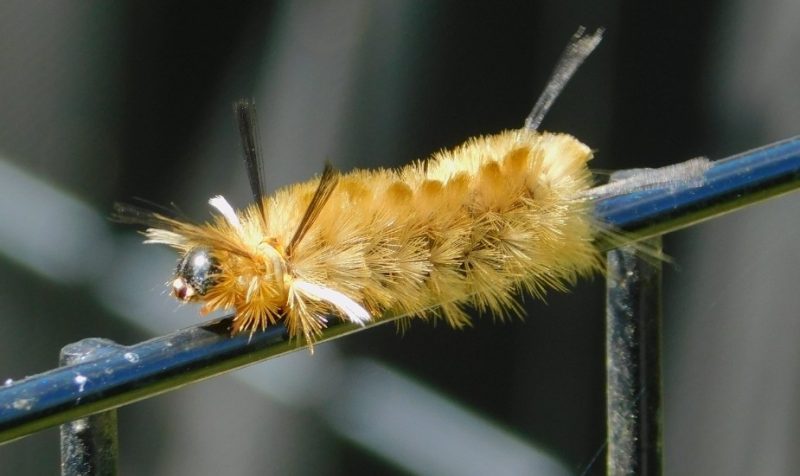
The Banded Tussock Moth Caterpillar is a fuzzy, multicolored species found throughout Ohio’s woodlands and suburban areas. Its long tufts of yellow, orange, and white hairs, combined with a line of black lashes along the body, make it one of the most beautiful yet irritating caterpillars in the region. Although not dangerously venomous, its hairs can still cause mild allergic reactions or irritation.
It typically grows between 1 and 1.5 inches long. The caterpillar’s body is covered in urticating (irritating) hairs that can cause skin inflammation, itching, and redness. These hairs are not connected to venom glands like those of more toxic species, but they can still embed in the skin and trigger discomfort, especially for individuals with sensitive skin or allergies.
Banded Tussock Moth Caterpillars feed on a wide range of deciduous trees, such as oak, birch, walnut, and maple. They are often seen crawling along tree trunks or walls in late summer as they search for places to pupate. Their abundance in Ohio’s urban areas means they are frequently encountered by residents.
These caterpillars are peaceful creatures, relying on their fuzzy appearance as a deterrent rather than aggression. When disturbed, they often curl up defensively. While their sting is mild, it’s still wise to avoid touching them directly and to handle them with gloves if removal is necessary.
American Dagger Moth Caterpillar (Acronicta americana)
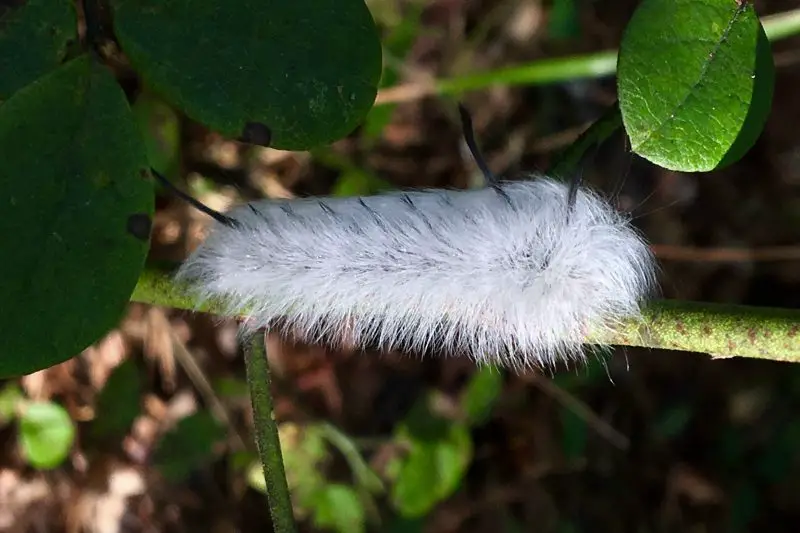
The American Dagger Moth Caterpillar is one of the largest and most distinctive stinging caterpillars found in Ohio. It has a bright yellow to white body covered with long, soft hairs and several black bristles near the front and rear. Despite its fuzzy appearance, it can cause moderate skin irritation or rashes when handled.
Fully grown larvae reach up to 2 inches long. The long setae are connected to tiny spines that can puncture the skin, causing red, itchy welts. While not highly venomous, the irritation can be unpleasant and may persist for a day or two. In some cases, brushing against multiple caterpillars can lead to more severe reactions, including swelling and a burning sensation.
The American Dagger Moth Caterpillar feeds on a variety of hardwood trees such as oak, maple, birch, and elm. It is common in Ohio’s forests, parks, and residential areas. They are most active from late summer to early fall, when they wander from trees in search of a suitable site to pupate.
Their behavior is relatively docile; they rely on their hair as a passive defense. When disturbed, they often arch their body or remain motionless. Although their sting is not medically serious, it’s advisable to avoid direct contact and wash the affected area if exposed to their hairs. These caterpillars eventually transform into attractive gray moths that play an important role in the ecosystem as pollinators.
How to Treat Caterpillar Stings in Ohio
Encountering a stinging caterpillar in Ohio can be an unpleasant surprise, especially since many of them appear harmless or even beautiful. Fortunately, most reactions are temporary and can be managed effectively with proper first aid. However, understanding how to respond immediately can prevent infection, reduce pain, and speed up healing.
Immediate First Aid Steps
If you come into contact with a stinging caterpillar, do not rub or scratch the affected area. Doing so can drive the venomous spines deeper into your skin and worsen irritation. Instead, follow these steps:
-
Remove any visible spines or hairs using adhesive tape. Gently press the tape onto the skin and lift it away to pull out embedded hairs. Repeat with fresh tape if necessary.
-
Wash the area thoroughly with soap and cold water to remove toxins and prevent secondary infections.
-
Apply ice packs or cold compresses to reduce pain, swelling, and inflammation. Keep the compress in place for 10–15 minutes at a time.
-
Use topical treatments such as calamine lotion, hydrocortisone cream, or baking soda paste to relieve itching and burning sensations.
-
Take an oral antihistamine if you experience itching or mild allergic reactions. Over-the-counter medications like Benadryl can help reduce discomfort.
When to Seek Medical Attention
While most caterpillar stings in Ohio cause only mild to moderate pain, medical help should be sought if symptoms worsen or spread. Seek professional care if you experience:
-
Severe or persistent pain lasting more than several hours
-
Swelling extending beyond the sting site
-
Nausea, dizziness, or difficulty breathing
-
Signs of infection (pus, increased redness, or warmth at the sting site)
-
Allergic reactions such as hives or swelling of the face and throat
In rare cases — especially with species like the Puss Caterpillar — reactions can be intense and may require medical evaluation for pain relief or antihistamine injections.
Prevention Tips
Avoiding caterpillar stings is easier than treating them. If you live in or visit Ohio during summer and fall, keep these precautions in mind:
-
Wear gloves and long sleeves when gardening, pruning, or collecting leaves.
-
Avoid touching unknown caterpillars, no matter how soft or fuzzy they look.
-
Teach children to observe, not handle, caterpillars they find outdoors.
-
Inspect outdoor furniture, fences, and walls, where migrating caterpillars often rest before pupating.
-
Gently relocate caterpillars with a stick or leaf instead of your hands if they are in unwanted areas.
By staying cautious and informed, you can appreciate Ohio’s unique caterpillar species without the sting that comes with curiosity.
FAQs About Stinging Caterpillars in Ohio
What is the most venomous caterpillar in Ohio?
The Puss Caterpillar (Megalopyge opercularis) is considered the most venomous in Ohio and across North America. Its dense fur conceals venomous spines capable of causing severe burning pain, swelling, and even systemic reactions in sensitive individuals.
Are stinging caterpillars common in Ohio?
Yes. Many species such as the Saddleback Caterpillar, Io Moth Caterpillar, and Spiny Oak Slug are common during late summer and early fall. They are more frequently encountered in wooded areas, parks, and gardens where host trees are abundant.
Can caterpillar stings be deadly?
While extremely painful, most caterpillar stings in Ohio are not fatal. However, severe allergic reactions can occur, particularly from contact with the Puss Caterpillar. Immediate medical attention is recommended if symptoms like difficulty breathing, dizziness, or severe swelling occur.
How long do the effects of a caterpillar sting last?
For most people, pain and irritation last between a few hours to a day. In more sensitive individuals, symptoms such as redness, itching, and welts may persist for two or three days. Prompt cleaning and treatment can significantly shorten recovery time.
Do stinging caterpillars become dangerous moths?
No. Adult moths of these species are harmless to humans. The venomous traits are unique to the caterpillar stage as a form of defense. Once they pupate and emerge as moths, they lose their stinging spines and pose no threat.
When is the best time to watch for stinging caterpillars in Ohio?
They are most active from July through October, when many species reach their final growth stages before pupation. During these months, be extra cautious around trees like oak, maple, and birch — common host plants for stinging caterpillars.
What should I do if my pet touches a stinging caterpillar?
If your cat or dog comes into contact with one, remove the caterpillar immediately with gloves and rinse the affected area with cool water. Watch for excessive licking, swelling, or discomfort. If symptoms persist, consult a veterinarian.





